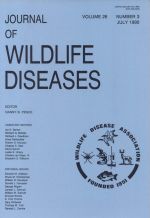The ability of raccoons (Procyon lotor), striped skunks (Mephitis mephitis) and opossums (Didelphis virginiana) to serve as reservoirs of Borrelia burgdorferi, the spirochetal agent of Lyme disease, was compared with that of white-footed mice (Peromyscus leucopus). Twenty-eight (28) medium-sized mammals and 34 white-footed mice were captured in Westchester County, New York (USA) in summer 1986. Animals were caged over pans of water for 1 to 2 days to recover engorged tick larvae (Ixodes dammini) that detached from the hosts after feeding. With the exception of mice, numbers of engorged tick larvae recovered exceeded those counted during initial examinations of the hosts by 30% (opossums) to nearly 90% (raccoons). Newly-molted nymphal ticks derived from the engorged larvae were examined for the presence of spirochetes by darkfield microscopy. Percentage infection was 5% (n = 22) for ticks from skunks and 14% (n = 191) for ticks from raccoons. None of 24 nymphs from larvae that fed on opossums survived long enough for spirochete examination. By comparison, 40% (n = 72) of nymphs from larvae which fed on white-footed mice were infected. Of the individual hosts from which molted nymphs had fed as larvae, 67% of mice, 33% of skunks, and 55% of raccoons produced spirochete-positive ticks.
How to translate text using browser tools
1 July 1990
THE ROLE OF MEDIUM-SIZED MAMMALS AS RESERVOIRS OF BORRELIA BURGDORFERI IN SOUTHERN NEW YORK
Durland Fish,
Thomas J. Daniels

Journal of Wildlife Diseases
Vol. 26 • No. 3
July 1990
Vol. 26 • No. 3
July 1990
Arachnida
Borrelia burgdorferi
field study
Ixodes dammini
Lyme disease
reservoirs
ticks




